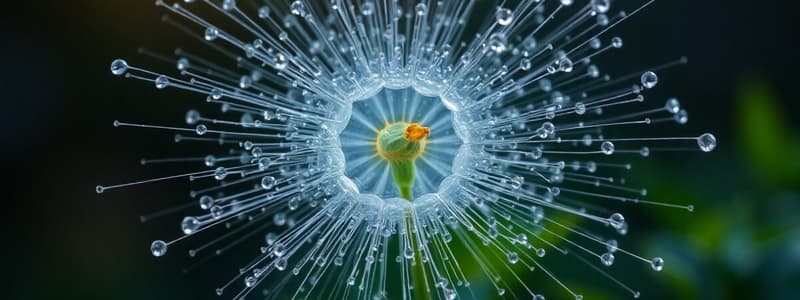Podcast
Questions and Answers
What was kept out by the seal according to Needham?
What was kept out by the seal according to Needham?
The vital force for spontaneous generation
What did Needham retort about spontaneous generation?
What did Needham retort about spontaneous generation?
The vital force for spontaneous generation was destroyed by heating and kept out by the seal.
What are the major classes of microorganisms?
What are the major classes of microorganisms?
Bacteria, Viruses, Fungi, Algae, Protozoa
What is taxonomy?
What is taxonomy?
Who developed the first natural classification based on anatomical characteristics?
Who developed the first natural classification based on anatomical characteristics?
Which of the following characteristics apply to bacteria?
Which of the following characteristics apply to bacteria?
Match the type of bacteria with their nutritional strategies:
Match the type of bacteria with their nutritional strategies:
Bacteria that can swim are called ______.
Bacteria that can swim are called ______.
Obligate aerobe bacteria can live without oxygen.
Obligate aerobe bacteria can live without oxygen.
Bacteria predominantly reproduce asexually by ______.
Bacteria predominantly reproduce asexually by ______.
Which of the following methods cannot be used by bacteria to exchange genes?
Which of the following methods cannot be used by bacteria to exchange genes?
Flashcards are hidden until you start studying
Study Notes
Spontaneous Generation Debate
- Needham argued that the vital force necessary for spontaneous generation was eliminated through heating and prevented from entering by the seal on experiments.
Historical Context
- Spontaneous generation refers to the idea that life can arise from non-living matter.
- This theory was widely accepted until the 19th century, when experiments challenged its validity.
Important Figures
- Needham: Advocated for the possibility of spontaneous generation, emphasizing the role of a vital force.
- Critics: Following Needham's work, scientists like Louis Pasteur conducted experiments that contradicted the idea of spontaneous generation.
Experimental Methods
- Needham's experiments involved heating broth in sealed containers, which he believed demonstrated life could still arise if the vital force was present.
Scientific Evolution
- The debate over spontaneous generation led to the development of germ theory, shifting focus to microorganisms as the source of life.
- The work of future scientists solidified the understanding that life arises from existing life, not spontaneously from non-living material.
Major Classes of Microorganisms
- Microorganisms include Bacteria, Viruses, Fungi, Algae, and Protozoa.
- Each class has distinct characteristics and medical importance.
Taxonomy Overview
- Taxonomy involves classification, nomenclature, and identification of organisms.
- Classification groups organisms into taxa based on mutual similarities.
- Nomenclature assigns names to taxonomic groups as per established rules.
- Identification confirms if an organism belongs to a recognized taxon.
Bacterial Taxonomy
- "Bergey’s Manual of Determinative Bacteriology" is a key resource for categorizing prokaryotes.
- Developed by Carolus Linnaeus, who created the first natural classification based on anatomical characteristics.
Bacterial Characteristics
- Bacteria are the smallest living cells, ranging from 0.1 to 10µm in size.
- Approximately 5,000 species of bacteria have been identified, with over 90% being harmless or beneficial.
Bacterial Morphology
- Bacteria are prokaryotic, lacking membrane-bound organelles.
- They have a cytoplasmic membrane surrounded by a rigid cell wall made of peptidoglycan.
- Morphological shapes include cocci (spherical), bacilli (rod-shaped), spirochetes (spiral), and vibrio (curved).
Bacterial Motility
- Bacteria can be motile (able to swim) due to flagella or axial filaments or nonmotile (unable to swim).
Nutrition and Growth
- Bacterial nutrition types include:
- Parasites: Obtaining energy from live organic matter.
- Heterotrophs: Breaking down organic materials from other organisms; includes saprophytes (from decaying matter).
- Autotrophs: Create their own food from sunlight or minerals.
- Bacteria are classified as:
- Aerobes: Use oxygen for respiration.
- Anaerobes: Do not use oxygen (energy through fermentation).
- Obligate aerobes: Require oxygen to live.
- Obligate anaerobes: Cannot tolerate oxygen.
- Facultative anaerobes: Can grow with or without oxygen.
Reproduction
- Bacteria primarily reproduce asexually through binary fission.
- Endospore formation involves:
- DNA replication and alignment.
- Membrane invagination around DNA.
- Formation of cortex and spore coat.
- The mature spore is released after cell lysis.
Gene Exchange in Bacteria
- Bacteria can exchange genetic material through three mechanisms:
- Conjugation: Gene transfer via pilus contact between cells.
- Transformation: Uptake of naked DNA from the environment.
- Transduction: Gene transfer via bacteriophages (viruses that infect bacteria).
Studying That Suits You
Use AI to generate personalized quizzes and flashcards to suit your learning preferences.



